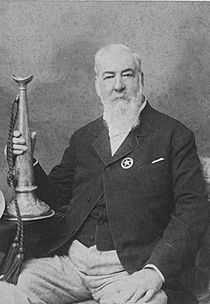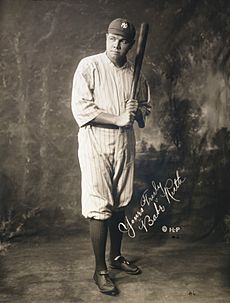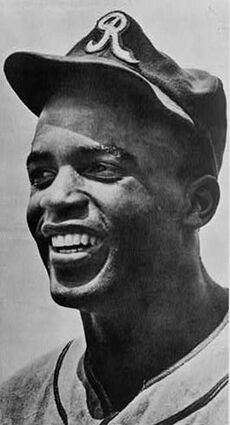History of baseball facts for kids
The history of baseball is a fascinating journey. It covers how the game changed over time, where it was played, and how it was organized. Baseball also reflects political and cultural influences. The game grew from older bat-and-ball games played in England in the mid-1700s. Immigrants brought these games to North America. Here, the modern version of baseball really took shape. By the late 1800s, baseball was known as the national sport of the United States. Today, baseball is popular in North America, parts of Central and South America, the Caribbean, and East Asia. Countries like Japan, South Korea, and Taiwan love the sport.
The earliest mentions of baseball go back to the 1700s. In England, a children's book from 1744 called A Little Pretty Pocket-Book by John Newbery talked about "base-ball." This was likely a game similar to "rounders." In the early 1800s, "baseball" and "rounders" might have been very similar games. Organized amateur baseball clubs started in eastern US cities in the 1830s and 1840s. The first official game with a score card happened in Canada in 1838. While Canada had early versions, New York City clubs made changes that led to the modern game we know. These clubs created a national group with rules in 1858. This was the National Association of Base Ball Players. The first professional league, the National Association of Professional Base Ball Players, began in 1871. Five years later, the National League was formed. The American League followed in 1901. The first World Series between the two major leagues was in 1903. By 1905, it became an annual event. Early 20th-century baseball had low scores. But the "dead-ball era" ended in the 1920s with rule changes and the rise of power hitter Babe Ruth. Major League Baseball had a rule that kept black players out until 1947. That's when Jackie Robinson made his famous debut. The major leagues started adding more teams in 1961. Fan attendance grew from the mid-1970s until 1994. A player strike that year stopped the World Series.
Professional baseball teams from Canada played as early as 1877. The sport spread to many countries in the 1800s and 1900s. Baseball was an Olympic medal sport from 1992 to 2008. Other international competitions include the Baseball World Cup and the World Baseball Classic. The World Baseball Classic first took place in 2006.
Contents
How Baseball Began
It's hard to know exactly how baseball grew from older bat-and-ball games. A French book from 1344 shows a game with similarities to baseball. Other old French games also seem related. Many people used to think that today's baseball came from the game "rounders," popular in Great Britain and Ireland. But a book by David Block in 2005 suggests baseball started in England. New historical facts support this idea. Block believes rounders and early baseball were different versions of the same game. He thinks the closest ancestors are English games like "stoolball" and "tut-ball."
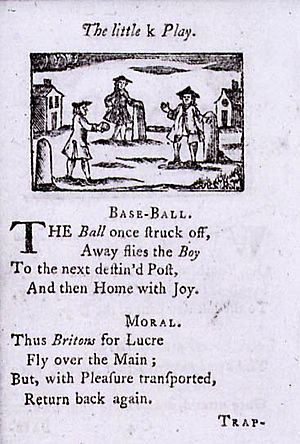
The first known mention of baseball is in a 1744 British children's book, A Little Pretty Pocket-Book. It has a poem about "base-ball" and a picture. The picture shows a field somewhat like modern baseball. But it was triangular, not a diamond, and used posts instead of bases. David Block found that the first recorded game of "Bass-Ball" happened in 1749 in England. The Prince of Wales even played in it. An English lawyer, William Bray, wrote about a baseball game in 1755. This early form of the game came to Canada with English immigrants. Rounders also came to the United States from Canada. The first American mention of baseball is in a 1791 town rule in Massachusetts. It stopped people from playing the game near the town's meeting house. By 1796, a German scholar wrote about "englische Base-ball." He described it as two teams playing. The batter had three tries to hit the ball. Only one out was needed to end a team's turn.
In 1828, a book called The Boy's Own Book was published in London. It included the rules of rounders. It was the first time a bat and ball game played on a diamond was described in print. The next year, this book was published in Boston, Massachusetts.
By the early 1830s, different bat-and-ball games like early baseball were played in North America. These games were often called "town ball." Other names like "round-ball" and "base-ball" were also used. One of the earliest detailed descriptions of such a game was in Beachville, Ontario, in 1838. It had many similarities to modern baseball, but also some differences. For example, it had five bases, and a batter was out if a hit ball was caught after the first bounce.
The popular story that US Army officer Abner Doubleday invented baseball in Cooperstown, New York, in 1839 is not true. Sports historians have shown this is a myth. This story came about because people argued if baseball was invented in the US or if it came from rounders.
In 1845, Alexander Cartwright was a member of the Knickerbocker Club in New York City. He wrote down a set of baseball rules. These are now called the Knickerbocker Rules. One important rule was that players could no longer be put out by being hit with a thrown ball. This allowed a smaller, harder ball to be used. Other rules also made the Knickerbockers' game similar to today's. However, a ball caught after the first bounce was still an out. Also, only underhand pitching was allowed. The first officially recorded baseball game in US history happened on June 19, 1846, in Hoboken, New Jersey. The "New York Nine" beat the Knickerbockers, 23–1. The Knickerbocker rules became the base for how modern baseball rules kept changing over the next 50 years.
Baseball in the United States
How Professional Leagues Started
In the mid-1850s, baseball became very popular in the New York area. By 1856, local newspapers called baseball the "national pastime." After the American Civil War, baseball became more popular than cricket in the United States. This was partly because baseball games were much shorter. In 1857, 16 clubs formed the sport's first governing body, the National Association of Base Ball Players. In 1863, they changed a rule so that catching a fair ball after one bounce was no longer an out. Four years later, the group stopped African Americans from playing.
Baseball's business potential grew. In 1869, the first fully professional baseball club, the Cincinnati Red Stockings, was formed. They won every game against other teams that year. They are still the only undefeated team in a regular season. The first professional league, the National Association of Professional Base Ball Players, lasted from 1871 to 1875.
The more organized National League was founded in 1876. It is the oldest major league still playing today. Other major leagues started and then failed. In 1884, African American player Moses Fleetwood Walker played in one of these leagues. An injury ended his major league career. By the early 1890s, an unwritten rule, called the "baseball color line," stopped black players from joining white professional leagues. Because of this, professional Negro leagues were formed. These leagues quickly became very popular. Independent African American teams also became successful. Also in 1884, overhand pitching became legal. By 1893, almost all modern baseball rules were in place. The last big change was in 1901. This rule made foul balls count as strikes. The National League's first successful partner, the American League, started that same year. The two leagues, each with eight teams, were rivals. They fought for the best players and had many disagreements.

Eventually, the leagues found a way to work together. This led to the National Agreement of 1903. This agreement set up rules for the two major leagues and the minor professional leagues. The National Baseball Commission was created to oversee all of Organized Baseball. The World Series, where the two major league champions play each other, started that fall. The Boston Americans of the American League beat the Pittsburgh Pirates of the National League. The next year, the World Series was not played. The National League champion New York Giants refused to play. In 1905, the Giants agreed to play. This made the World Series the annual championship event for the major leagues.
As professional baseball made more money, players often complained to owners. They wanted more control and fairer pay. In the early years, players sometimes tried to strike. But these strikes usually failed because their jobs were at risk. Strict contract rules and the "reserve clause" kept players tied to their teams. This meant players had to stay with their team even after their contracts ended. In 1919, some players on the Chicago White Sox decided to lose the 1919 World Series on purpose. This was known as the Black Sox Scandal. This scandal led to the end of the National Baseball Commission. Instead, the office of the Commissioner of Baseball was created. The first commissioner, Kenesaw Mountain Landis, was chosen in 1920. That year also saw the start of the Negro National League. This was the first important Negro league. It played until 1931.
For many years, Major League Baseball only had white players. African Americans played baseball all over the country. But they could not play in the MLB because of segregation. This led them to create their own leagues, known as the Negro Leagues. Despite unfair treatment, these leagues became very popular. Teams like the Kansas City Monarchs and Homestead Grays drew huge, excited crowds. They were known for their tough games. The Negro League teams gave black communities a sense of pride and unity. They brought joy and hope during a difficult time in our country. These leagues eventually ended after the MLB allowed black players. But their legacy lives on.
The Rise of Babe Ruth and Integration
In the early 1900s, professional baseball games had lower scores than today. Pitchers like Walter Johnson were very dominant. This time was called the "dead-ball era." It ended in the early 1920s because of rule changes. These changes helped hitters. New rules about the ball's size and how it was made helped. Also, a new rule banned the "spitball" and other pitches that used foreign substances on the ball. This rule came after a player, Ray Chapman, died after being hit in the head by a pitch in 1920. Better materials after World War I also made the ball travel farther when hit. More seats were added to stadiums as the game grew popular. This often made outfield fences closer, leading to more home runs. The rise of the famous player Babe Ruth also changed the game forever. He was the first great power hitter of this new era. His team, the New York Yankees, became known as the best team in the major leagues.
In the late 1920s and early 1930s, St. Louis Cardinals manager Branch Rickey invested in many minor league clubs. He created the first modern "farm system." A new Negro National League started in 1933. Four years later, the Negro American League joined it. The first players were chosen for the National Baseball Hall of Fame in 1936. In 1939, Little League Baseball was founded in Pennsylvania. By the late 1940s, it organized children's baseball leagues across the United States.
During World War II, many professional players left to serve in the military. Many minor league teams closed, and the major league game seemed at risk. The owner of the Chicago Cubs, Philip K. Wrigley, helped start a new professional league with women players. This was the All-American Girls Professional Baseball League. It existed from 1943 to 1954. The first College World Series was held in 1947. The Babe Ruth League youth program was also founded. This program became another important group for children's baseball.
The rule against black players in white professional baseball began to break in 1946. Jackie Robinson signed with the National League's Brooklyn Dodgers. Branch Rickey was the general manager there. Robinson started playing for their minor league team in Montreal. On April 15, 1947, Robinson broke the major leagues' color barrier when he played for the Dodgers. Larry Doby played for the American League's Cleveland Indians later that year. More Latin American players also started joining the major leagues. In 1951, two Chicago White Sox players, Chico Carrasquel and Minnie Miñoso, became the first Hispanic All-Stars.
Baseball attendance went down because of new competition like television and football. While the major leagues recovered by the mid-1950s, the minor leagues suffered. Hundreds of amateur teams also disappeared. Allowing black players into the league happened slowly. By 1953, only six of the 16 major league teams had a black player. That year, the Major League Baseball Players Association was founded. It was the first professional baseball union that lasted. But it wasn't very effective for many years. No major league team was located west of St. Louis until 1958. That's when the Brooklyn Dodgers moved to Los Angeles and the New York Giants moved to San Francisco. The last major league team to add a black player was the Boston Red Sox in 1959. With black players joining the major leagues, the last Negro league closed the next year. In 1961, the American League added a team on the West Coast, the Los Angeles Angels. The major league season was also extended from 154 games to 162. This helped Roger Maris break Babe Ruth's home run record. Along with the Angels, three other new teams started in 1961–62. This was the first major league expansion in 60 years. Each league now had ten teams.
With so much talent in the Negro Leagues, black players wanted to prove themselves in the MLB. A big step for integration was the death of commissioner Kenesaw Mountain Landis. He had played a large role in keeping the MLB segregated. Jackie Robinson faced much racism on and off the field. Despite this, he succeeded in paving the way for other African Americans. The integration of the MLB was a huge moment for sports. But it was even bigger for society. This was a major step in the fight for civil rights and desegregation. Before this, baseball, like many parts of American society, was separated by race. Because of Robinson and many other people, segregation was eventually abolished.
Baseball Today: Records and Changes
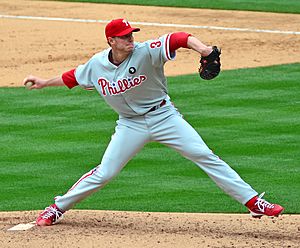
The players' union became stronger under Marvin Miller. He was elected executive director in 1966. On the field, major league pitchers became very dominant again. After the 1968 season, rules were changed to help hitters. The strike zone was made smaller, and the height of the pitcher's mound was lowered. In 1969, both the National and American Leagues added two more teams. The leagues were split into two divisions each. A new round of playoffs, the League Championship Series, was added. This series decided who would play in the World Series. Also that year, Curt Flood challenged the "reserve clause" in court. The major leagues' first general players' strike happened in 1972. It delayed the season's start for two weeks. To add more offense, the American League adopted the designated hitter rule the next year. In 1975, the union's power and players' salaries grew a lot. This was because the "reserve clause" was ended. This led to the free agency system. In 1977, two more teams joined the American League.
Major work stoppages happened again in 1981 and 1994. The 1994 strike forced the World Series to be canceled for the first time in 90 years. Fan attendance had been growing since the mid-1970s. In 1994, before the strike, the major leagues were setting records for attendance per game.
Two more teams were added after the 1993 season. This led to another change in how the major leagues were organized. Each league was now split into three divisions. The number of home runs increased a lot that year and in the short 1994 season. After play started again in 1995, this trend continued. A "wild card" team was added to the playoffs. Regular-season interleague play started in 1997. The second-highest attendance for a full season was set. The next year, Mark McGwire and Sammy Sosa both broke the single-season home run record. Two more new teams were added. In 2000, the National and American Leagues stopped being separate legal groups. Their identities were kept for scheduling. But rules and other functions were combined under Major League Baseball (MLB).
In 2001, Barry Bonds set the current record of 73 home runs in a single season. People had suspected that the big increase in power hitting was partly due to illegal substances. But this issue only got a lot of media attention in 2002. There was no penalty for using performance-enhancing drugs before 2004. In 2007, Bonds became MLB's all-time home run leader. He finished his career with 762 home runs. Total major and minor league attendance reached all-time highs. Even though many players were involved in the steroid scandal, their big hits became the main attraction of the major leagues. In contrast, Little League enrollment went down. After reaching its peak in 1996, it dropped 1 percent each year for the next decade. With stricter testing for performance-enhancing drugs, the balance between hitting and pitching changed in 2010. This year became known as the "Year of the Pitcher." Runs per game fell to their lowest level in 18 years. The strikeout rate was higher than it had been in 50 years.
Before the 2012 season, MLB changed its rules. They doubled the number of wild card teams in the playoffs to two per league. This added annual one-game playoffs between the wild card teams. MLB's playoffs expanded further in 2022. There are now three wild card teams per league, with six teams qualifying. The wild card game became a wild card series. Also that season, MLB started using the designated hitter in both leagues. This ended the National League's practice of pitchers batting for themselves.
Baseball Around the World
Baseball is known as America's pastime. But it is also well-established in many other countries. The history of baseball in Canada is closely linked to the sport in the United States. As early as 1877, a professional league had teams from both countries. While baseball is widely played in Canada, and many minor league teams have been there, the American major leagues did not include a Canadian club until 1969. That's when the Montreal Expos joined the National League. In 1977, the Toronto Blue Jays joined the American League. The Blue Jays won the World Series in 1992 and 1993. They are still the only team from outside the United States to do so. After the 2004 season, Major League Baseball moved the Expos to Washington, D.C. The team is now called the Nationals.
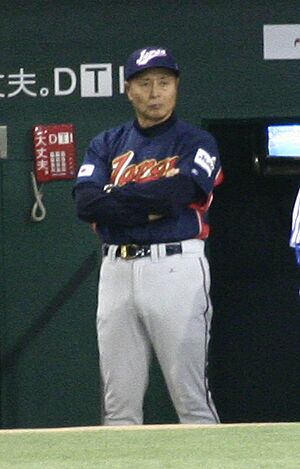
In 1847, American soldiers played what might have been the first baseball game in Mexico. They used a wooden leg captured from General Santa Anna. The first formal baseball league outside the United States and Canada started in 1878 in Cuba. Cuba has a rich baseball history. Its national team has been one of the world's strongest since international play began in the late 1930s. The Dominican Republic held its first island-wide championship in 1912. Professional baseball leagues began to form in other countries between the world wars. These included the Netherlands (1922), Australia (1934), Japan (1936), Mexico (1937), and Puerto Rico (1938). The Japanese major leagues are considered the highest quality professional leagues outside the United States. Japan also has a professional minor league system.
After World War II, professional leagues were founded in many Latin American countries. These included Venezuela (1946) and the Dominican Republic (1955). Since the early 1970s, the annual Caribbean Series has matched the champion clubs from the four main Latin American winter leagues. In Asia, South Korea (1982), Taiwan (1990), and China (2003) all have professional leagues.
Many European countries also have professional leagues. The most successful, other than the Dutch league, is the Italian league, founded in 1948. Compared to those in Asia and Latin America, the European leagues have had less widespread appeal. In 2004, Australia won a surprise silver medal at the 2004 Summer Olympics. The Confédération Européene de Baseball (European Baseball Confederation), founded in 1953, organizes many competitions. These are between clubs and national teams from different countries. Other competitions between national teams, like the Baseball World Cup and the Olympic baseball tournament, were managed by the International Baseball Federation (IBAF). By 2009, the IBAF had 117 member countries. Women's baseball is played in many countries. Since 2004, the Women's Baseball World Cup has featured national teams.
Baseball became an Olympic medal sport at the 1992 Summer Olympics. But it was removed from the 2012 Summer Olympics at a meeting in 2005. It was still part of the 2008 Summer Olympics. Baseball was removed partly because it wasn't popular in many parts of the world. More importantly, Major League Baseball didn't want to stop its season for the Games. This would push the playoffs into colder weather. To try and get back into the Olympics, the IBAF suggested a shorter competition. This would make it easier for top players to join. But the effort failed. Major League Baseball started the World Baseball Classic. This tournament happens before the major league season. It was partly created as a high-profile international tournament. The first Classic was in March 2006. It was the first tournament with national teams that included many MLB players. The World Baseball Classic happens every four years. It features the sixteen best national teams. Japan was the first team to win. The Baseball World Cup ended after its 2011 event. It was replaced by an expanded World Baseball Classic.
Images for kids
-
A Little Pretty Pocket-Book (1744) showed an illustration of base-ball. It had a batter, a bowler, and three posts. The poem talks about hitting the ball, running to the next post, and then home to score.



